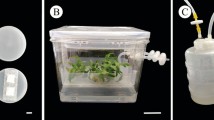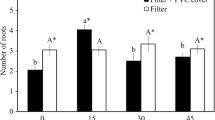Summary
Heterotrophic plantlets obtained by in vitro propagation are biochemically different compared to autotrophic plantlets. When heterotrophic plantlets are transferred to ex vitro conditions, higher irradiance levels are generally applied. Irradiance levels higher than those used in vitro lead to oxidative stress symptoms, that can be counteracted by CO2 concentrations above normal. We analyzed the stability and activity of Rubisco and leaf-soluble sugars and starch contents in chestnut plantlets transferred from in vitro to ex vitro conditions under four treatments obtained by associating two irradiances of 150 (low light, LL) and 300 (high light, HL) μmolm−2s−1, respectively three and six times in vitro irradiance, with two CO2 levels of 350 (low CO2, LCO2) and 700 (high CO2, HCO2) μll−1. In in vitro plantlets it was possible to immunodetect apparent products of degradation of Rubisco large subunit (LSU). In ex vitro plantlets, these degradation products were no longer dtected except under LL associated with LCO2. The decrease in soluble sugars and starch in plantlets under HL HCO2 gave an indication of a faster acquisition of autotrophic characteristics. However, under the same treatment, a down-regulation of Rubisco activity was observed. From the results taken as a whole, two aspects seem to be confirmed: HL HCO2 is more efficient in inducing an autotrophic behavior in chestnut ex vitro plantlets; actively growing systems as ex vitro plantlets reflect the down-regulation of Rubisco by HCO2 without accumulation of carbohydrates.
Similar content being viewed by others
References
Amâncio, S.; Rebordão, J. P.; Chaves, M. M. Improvement of acclimatization of micropropagated grapevine: photosynthetic competence and carbon allocation. Plant Cell Tiss. Organ Cult. 58:31–37; 1999.
Arigita, L.; González, A.; Tamés, R. S. Influence of CO2 and sucrose on photosynthesis and transpiration of Actinidia deliciosa explants cultured in vitro. Physiol. Plant. 135:166–173; 2002.
Arp, W. J. Effects of source-sink relations on photosynthetic acclimation to elevated CO2. Plant Cell Environ. 14:869–875; 1991.
Bowes, G. Facing the inevitable: plants and increasing atmospheric CO2. Annu. Rev. Plant Physiol. Plant Mol. Biol. 44:309–332; 1993.
Bradford, M. M. A rapid and sensitive method for the quantification of microgram quantities of protein utilizing the principle of protein dye binding. Anal. Biochem. 72:248–254; 1976.
Bushnell, T.; Bushnell, D.; Jagendorf, A. A purified zine protease of pea chloroplasts, EPI, degrades the large subunit of Ribulose-1,5-Bisphosphate Carboxylase/Oxygenase. Plant Physiol. 103:585–591; 1993.
Carvalho, L.; Amâncio, S. Effect of ex vitro conditions on growth and acquisition of autotrophic behaviour during the acclimatization of chestnut regenerated in vitro. Sci. Hort. 95:151–164; 2002a.
Carvalho, L. C.; Amâncio, S. Antioxidant defence system in plantlets transferred from in vitro to ex vitro: effects of increasing light intensity and CO2 concentration. Plant Sci. 162:33–40; 2002b.
Carvalho, L. C.; Esquível, M. G.; Martins, I.; Ricardo, C. P.; Amâncio, S. Monitoring the stability of Rubisco in micropropagated grapevine (Vitis vinifera L.) by two dimensional electrophoresis. J. Plant Physiol. 162:365–374; 2004.
Carvalho, L. C.; Osório, M. L.; Chaves, M. M.; Amâncio, S. Chlorophyll fluorescence as an indicator of photosynthetic functioning of in vitro grapevine and chestnut plantlets under ex vitro acclimatization. Plant Cell Tiss. Organ Cult. 67:271–280; 2001.
Casano, L. M.; Lascano, H. R.; Trippi, V. S. Hydroxyl radicals and a thylakoid-bound endopeptidase are involved in a light-and oxygen-induced proteolysis in oat chloroplasts. Plant Cell Physiol. 35:145–152; 1994.
Centritto, M.; Jarvis, P. Long-term effects of elevated carbon dioxide concentration and provenance on four clones of Sitka spruce (Picea sitchensis). II. Photosynthetic capacity and nitrogen use efficiency. Tree Physiol. 19:807–814; 1999.
Ceulemans, R.; Mousseau, M. Effects of elevated atmospheric CO2 on woody plants. New Phytol. 127:425–446: 1994.
Cheng, S.; Moore, B.; Seemann, J. Effects of short and long term elevated CO2 on the expression of ribulose-1,5-bisphosphate carboxylase/oxygenase genes and carbohydrate accumulation in leaves of Arabidopsis thaliana (L.) Heynh. Plant Physiol. 116:715–723; 1998.
de la Viña, G.; Pliego-Alfaro, F.; Driscoll, S.; Mitchell, V.; Parry, M.; Lawlor, D. Effects of CO2 and sugars on photosynthesis and composition of avocado leaves grown in vitro. Plant Physiol. Biochem. 37:587–595; 1999.
Desimone, M.; Henke, M.; Wagner, E. Oxidative stress induces partial degradation of the large subunit of ribulose-1,5-bisphosphate carboxylase/oxygenase in isolated chloroplasts of barley. Plant Physiol. 111:789–796; 1996.
Desimone, M.; Wagner, E.; Johanningmeier, U. Degradation of active-oxygen-modified ribulose-1,5-bisphosphate carboxylase/oxygenase by chloroplastic proteases requires ATP-hydrolysis. Planta 205:459–466; 1998.
Drake, B. G.; Gonzàlez-Meler, M. A.; Long, S. P. More efficient plants: a consequence of rising atmospheric CO2? Annu: Rev. Plant Physiol. Plant Mol. Biol. 48:607–637; 1997.
Esquível, M. G.; Ferreira, R. B.; Teixeira, A. R. Protein degradation in C3 and C4 plants with particular reference to ribulose bisphosphate carboxylase and glycolate oxidase. J. Exp. Bot. 49:807–816; 1998.
Ferreira, R. B.; Franco, E.; Teixeira, A. R. Covalent dimerization of ribulose bisphosphate carboxylase subunits by UV radiation. Biochem. J. 318:227–234; 1996.
Garcia-Ferris, C.; Moreno, J. Oxidative modification and breakdown of ribulose-1,5-bisphosphate carboxylase/oxygenase induced in Eugrena gracilis by nitrogen starvation. Planta 193:208–215; 1994.
Gonçalves, J. C.; Diogo, G.; Amâncio, S. In vitro propagation of chestnut (Castanea sativa×C. crenata): effects of rooting treatments on plant survival and anatomical changes during adventitious root formation. Sci. Hort. 72:265–275; 1998.
Greshoff, P. M.; Doy, C. H. Development and differentiation of haploid Lycopersicon esculentum (tomato). Planta 107:161–170; 1972.
Grout, B. W. W. Photosynthesis of regenerated plantlets in vitro, and the stresses of transplanting. Acta Hort. 230:129–135; 1988.
Hildbrand, M.; Fisher, A.; Feller, U. Protein catabolism in bean leaf disks: accumulation of a soluble fragment of ribulose-1,5-bisphosphate carboxylase/oxygenase under oxygen deficiency. J. Exp. Bot. 45:1197–1204; 1994.
Ishida, H.; Nishimori, Y.; Sugisawa, M.; Makino, A.; Mac, T. The large subunit of Ribulose-1,5-Bisphosphate Carboxylase/Oxygenase is fragmented into 37-kDa and 16-kDa polypeptides by active oxygen in the lysates of chloroplasts from primary leaves of wheat. Plant Cell Physiol. 38:471–479; 1997.
Kimball, B. A. Carbon dioxide and agricultural yield: assemblage and analysis of 430 prior observations. Agron. J. 75:509–540; 1983.
Koch, K. E. Carbohydrate-modulated gene expression in plants. Annu. Rev. Plant Physiol. Plant Mol. Biol. 47:509–540; 1996.
Kokubun, N.; Ishida, H.; Makino, A.; Mae, T. The degradation of the large subunit of ribulose-1,5-bisphosphate carboxylase/oxygenase into the 44-kDa fragment in the lysates of chloroplasts incubated in darkness. Plant Cell Physiol. 43:1390–1394; 2002.
Laemmli, U. K. Cleavage of structural proteins during the assembly of the head of bacteriophage T4. Nature 227:680–685; 1970.
Miller, A.; Tsai, C.; Hemphill, D.; Endres, M.; Rodermel, S.; Spalding, M. Elevated CO2 effects during leaf ontogeny: a new perspective on acclimation. Plant Physiol. 115:1195–1200; 1997.
Murashige, T.; Skoog, F. A revised medium for rapid growth and bioassays with tobacco tissue cultures. Physiol. Plant. 15:473–497; 1962.
Pospíšilová, J.; Synková, H.; Haisel, D.; Catský, J.; Wilhelmová, N.; Srámek, F. Effect of elevated CO2 concentration on acclimation of tobacco plantlets to ex vitro conditions. J. Exp. Bot. 50:119–126; 1999.
Sheen, J. Feedback control of gene expression. Photosyn. Res. 39:427–438; 1994.
Stitt, M. Rising CO2 levels and their potential significance for carbon flow in photosynthetic cells. Plant Cell Environ. 14:741–762; 1991.
Stitt, M.; Bulpin, P. W.; Rees, T. A. Pathway of starch breakdown in photosynthetic tissues of Pisum sativum. Biochim. Acta 544:200–214; 1978.
Stitt, M.; Lilley, R. M.; Gerhardt, R.; Heldt, H. W. Determination of metabolite in specific cells and subcellular compartments of plant leaves. Methods Enzymol. 174:518–522; 1989.
Stitt, M.; Schulze, D. Does Rubisco control the rate of photosynthesis and plant growth? An exercise in molecular ecophysiology. Plant Cell Environ. 17:465–487; 1994.
van Huylenbroeck, J. M.; Piqueras, A.; Deberg, P. C. Photosynthesis and carbon metabolism in leaves formed prior and during ex vitro acclimatization of micropropagated plants. Plant Sci. 134:21–30; 1998.
van Huylenbroeck, J. M.; Piqueras, A.; Deberg, P. C. The evolution of photosynthetic capacity and the antioxidant enzymatic system during acclimatization of micropropagated Galathea plants. Plant Sci. 135:59–66; 2000.
Vieitez, A. M.; Ballester, A.; Vieitez, E. In vitro plantlet regeneration of mature chestnut. J. Hort. Sci. 58:457–463; 1983.
Viestra, R. D. Protein degradation in plants. Annu. Rev. Plant Physiol. Plant Mol. Biol. 44:385–410; 1993.
Wetztein, H. I.; Sommer, H. E. Leaf anatomy of tissue cultured Liquidamber styraciflua (Hamamelidaceae) during acclimatization. Am. J. Bot. 69:1579–1586; 1982.
Woodrow, I. E.; Berry, J. A. Enzymatic regulation of photosynthetic CO2 fixation in C3 plants. Annu. Rev. Plant Physiol. Plant Mol. Biol. 39:533–594; 1988.
Yoshida, T.; Minamikawa, T. Successive amino-terminal proteolysis of the large subunit of ribulose-1,5-bisphosphate carboxylase/oxygenase by vacuolar enzymes from French bean leaves. Eur. J. Biochem. 238:317–324; 1996.
Yue, D.; Gosselin, A.; Desjardins, Y. Re-examination of the photosynthetic capacity of in vitro cultured strawberry plantlets. J. Am. Soc. Hort. Sci. 118:419–424; 1993.
Author information
Authors and Affiliations
Corresponding author
Rights and permissions
About this article
Cite this article
Carvalho, L.C., Esquível, M.G. & Amâncio, S. Stability and activity of rubisco in chestnut plantlets transferred to ex vitro conditions under elevated CO2 . In Vitro Cell.Dev.Biol.-Plant 41, 525–531 (2005). https://doi.org/10.1079/IVP2005665
Received:
Accepted:
Issue Date:
DOI: https://doi.org/10.1079/IVP2005665




